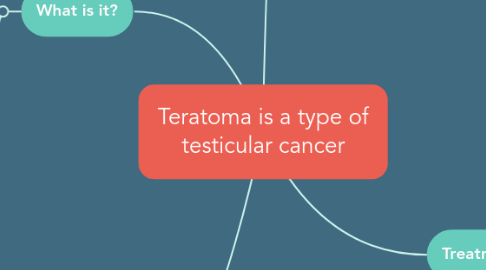Teratoma is a type of testicular cancer
Alison Edwards-wiksonにより


1. What is it?
1.1. It is a type of germ cell tumour as it arises from sperm precursors. Germ cell tumours are by far the most common testicular tumours.
1.2. An aggressive form of cancer. There are 3 main types of Teratomas.
2. Progression of this cancer
2.1. This type of cancer tumour spreads by blood and lymphatic routes. Which as we know blood spread to the lungs, liver, bone and brain occurs relatively early in the course so many patients may present with already advanced disease. It tends to spread to lymph nodes next to the aorta.
2.1.1. There is a 5 year survival rates for testicular teratoma for approximately 90% in patients with good prognostic features. In patients diagnosed later in the course of the disease a 5 year survival is only 50%.
3. Symptoms?
3.1. A painless lump in the testicle which is the most common sign
3.2. Swelling of the testicle (with or without pain) or a feeling of weight in the scrotum
3.3. Pain or a dull ache in the testicle, scrotum or groin
3.4. Tenderness or changes in the male breast tissue
4. Treatments?
4.1. What happens if I have suspicions of testicular cancer or teratoma? -your GP will perform several tests -Scrotal ultrasound -This is followed by blood tests -Also radiographic imaging may include CT scan of the abdomen, chest and chest x-ray.
4.2. Testicular cancer treatment involves radical surgical inguinal orchidectomy (removal of the testicle). Teratoma of the testicle is relatively resistant to radiotherapy but responds well to chemotherapy. -There is an option of semen cryopreservation prior to the commencement of therapy in case you plan to have more children in the future.
4.2.1. Follow up includes: -Self-testicular examination -Measurement of tumour markers in the blood -Chest x-ray -Abdominal and thoracic CT scanning. You may also require treatment of specific symptoms from spread of the tumour such as pain from nerve compression and coughing from lung metastases.

